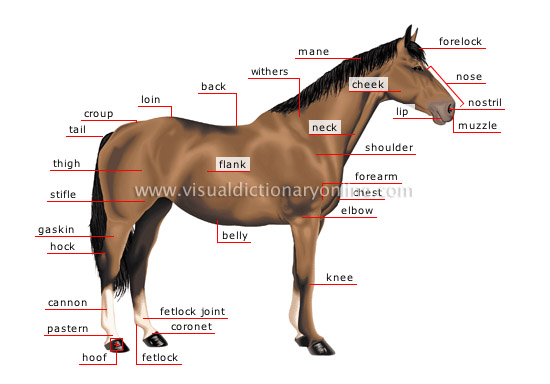morphology of a horse
mane 
Long stiff hairs (horsehair) covering the neck used mainly to chase away insects.
withers 
Portion of the body extending the neck and forming a protuberance above the shoulder.
back 
Upper portion of the trunk opposite the belly between the withers and the loin.
loin 
Upper portion of the body between the back and the croup; it transmits forward the propulsion from the hind limbs.
croup 
Rear portion of the body between the loin and the base of the tail; it provides propulsion.
flank 
Lateral portion of the body that ripples with the action of the muscles, which allows the horse to chase away insects and warm itself.
tail 
Terminal appendage of the body with long hairs; the horse whips its tail to chase away insects.
thigh 
Upper portion of the hind limb having large powerful muscles.
stifle 
Articulation of the hind limb between the thigh and the leg formed of the patella and the skin that covers it.
gaskin 
Portion of the hind limb between the stifle and hock.
hock 
Articulation of the hind limb; it contributes to movement and absorbs shocks.
cannon 
Portion of the hind limb between the hock and the fetlock joint supporting the horse’s weight.
pastern 
Portion of the limbs between the fetlock joint and the coronet, corresponding to the first phalange of the finger.
hoof 
Thick corneous casing covering and protecting the terminal end of the limb; it rests on the ground while the horse is walking and absorbs shocks.
coronet 
Part of the limbs covering the upper edge of the hoof and corresponding to the second phalange of the finger.
fetlock 
Tuft of hair located behind the fetlock joint.
fetlock joint 
Articulation of the limbs between the cannon and the pastern forming a protuberance and acting as a shock absorber.
belly 
Lower portion of the trunk opposite the back.
knee 
Articulation of the forelimb located below the elbow between the forearm and the cannon; it contributes to movement and acts as a shock absorber.
elbow 
Articulation of the forelimb between the upper arm and the forearm above the knee.
forearm 
Part of the forelimb located between the shoulder and the elbow corresponding to the humerus.
chest 
Front portion of the body located between the neck and the limbs.
shoulder 
Upper portion of the forelimb attached to the trunk.
neck 
Portion of the body supporting the head and attached to the withers, the shoulders and the chest.
cheek 
Protruding side of the head behind the upper jaw.
lip 
Each of two movable muscular folds forming the contour of the mouth and having a tactile function.
muzzle 
Terminal end of the upper lip having a tactile and prehensile function.
nostril 
Each of the orifices of the nose having a respiratory and olfactory function.
nose 
Front portion of the head extending from the base of the eyes to the nostrils.
forelock 
Tuft of long stiff hairs (horsehair) on the upper terminal end of the mane and falling onto the forehead between the ears.














